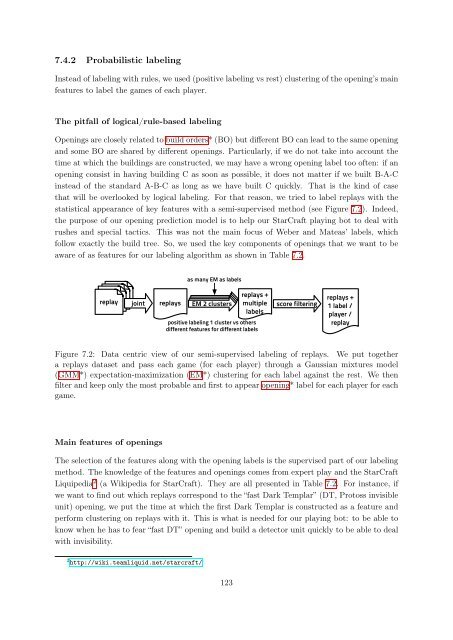Bayesian Programming and Learning for Multi-Player Video Games ...
Bayesian Programming and Learning for Multi-Player Video Games ...
Bayesian Programming and Learning for Multi-Player Video Games ...
You also want an ePaper? Increase the reach of your titles
YUMPU automatically turns print PDFs into web optimized ePapers that Google loves.
7.4.2 Probabilistic labeling<br />
Instead of labeling with rules, we used (positive labeling vs rest) clustering of the opening’s main<br />
features to label the games of each player.<br />
The pitfall of logical/rule-based labeling<br />
Openings are closely related to build orders* (BO) but different BO can lead to the same opening<br />
<strong>and</strong> some BO are shared by different openings. Particularly, if we do not take into account the<br />
time at which the buildings are constructed, we may have a wrong opening label too often: if an<br />
opening consist in having building C as soon as possible, it does not matter if we built B-A-C<br />
instead of the st<strong>and</strong>ard A-B-C as long as we have built C quickly. That is the kind of case<br />
that will be overlooked by logical labeling. For that reason, we tried to label replays with the<br />
statistical appearance of key features with a semi-supervised method (see Figure 7.2). Indeed,<br />
the purpose of our opening prediction model is to help our StarCraft playing bot to deal with<br />
rushes <strong>and</strong> special tactics. This was not the main focus of Weber <strong>and</strong> Mateas’ labels, which<br />
follow exactly the build tree. So, we used the key components of openings that we want to be<br />
aware of as features <strong>for</strong> our labeling algorithm as shown in Table 7.2.<br />
replays<br />
replays<br />
replays<br />
replay joint replays<br />
as many EM as labels<br />
EM 2 clusters<br />
replays +<br />
multiple<br />
labels<br />
positive labeling 1 cluster vs others<br />
different features <strong>for</strong> different labels<br />
score filtering<br />
replays +<br />
1 label /<br />
player /<br />
replay<br />
Figure 7.2: Data centric view of our semi-supervised labeling of replays. We put together<br />
a replays dataset <strong>and</strong> pass each game (<strong>for</strong> each player) through a Gaussian mixtures model<br />
(GMM*) expectation-maximization (EM*) clustering <strong>for</strong> each label against the rest. We then<br />
filter <strong>and</strong> keep only the most probable <strong>and</strong> first to appear opening* label <strong>for</strong> each player <strong>for</strong> each<br />
game.<br />
Main features of openings<br />
The selection of the features along with the opening labels is the supervised part of our labeling<br />
method. The knowledge of the features <strong>and</strong> openings comes from expert play <strong>and</strong> the StarCraft<br />
Liquipedia 2 (a Wikipedia <strong>for</strong> StarCraft). They are all presented in Table 7.2. For instance, if<br />
we want to find out which replays correspond to the “fast Dark Templar” (DT, Protoss invisible<br />
unit) opening, we put the time at which the first Dark Templar is constructed as a feature <strong>and</strong><br />
per<strong>for</strong>m clustering on replays with it. This is what is needed <strong>for</strong> our playing bot: to be able to<br />
know when he has to fear “fast DT” opening <strong>and</strong> build a detector unit quickly to be able to deal<br />
with invisibility.<br />
2 http://wiki.teamliquid.net/starcraft/<br />
123


